White clover seed produces a perennial herbage legume. The key to its survival and production potential is the stolon (multi-branched creeping stem), as this provides the sites for new leaves, roots and flowers.
The stolon is a store for carbohydrates and proteins and provides the ability for the plant to over-winter and regenerate in the spring.
Contents
- Understanding white clover
- Benefits of planting white clover seed
- Characteristics of white clover and perennial ryegrass
- Establishment options
- Grazing systems in practice
- Key developments
- Variety choice
Understanding white clover
Varieties of white clover (Trifolium repens) vary in their leaf and stolon characteristics, and it is these often quite marked differences that help to determine agronomic performance.
The latest breeding development within has introduced a variety with both stoloniferous and rhizomatous root structures, to aid grazing tolerance, drought tolerance and winter hardiness.
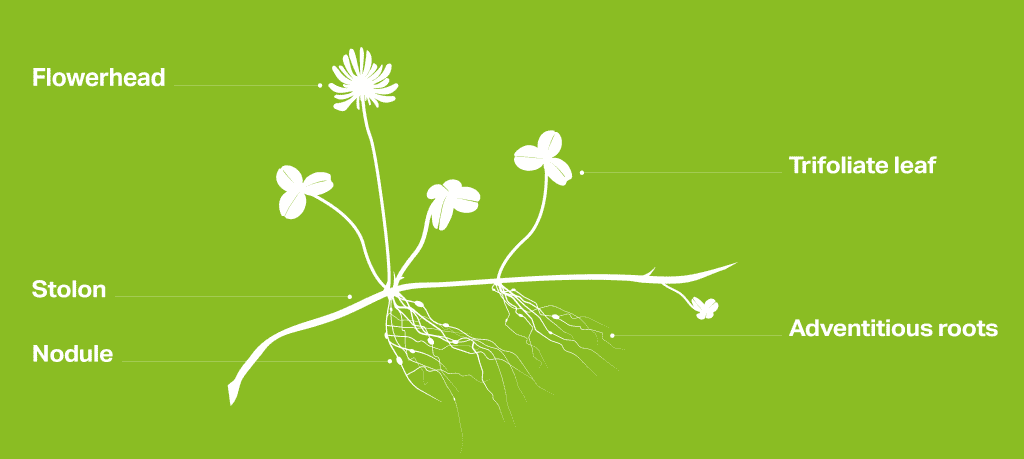
Source: Germinal
White clover seed in sustainable agriculture
- Reduce reliance on fertiliser nitrogen (150-250 kg N/ha/annum)
- Enhance summer grazing productivity
- Homegrown protein source (25-30% crude protein)
- Increase forage intake and enhance nutrient supply
- Improve soil structure
- Fertility building
- Attract pollinators
- Suitable for inclusion in multi-species swards
Using a white clover grass seed mix
White clover is nearly always grown with companion grass, and most typically with ryegrass, with the type of ryegrass being dependent upon the primary use of the sward.
Breeding developments have increased the versatility of its use and longevity within grass swards, with greater nitrogen tolerance being a key feature in more intensive systems.
Sustainable systems incorporating white clover grass seed range from long-term leys for continuous sheep grazing (using small-leaf varieties such as AberAce) through to medium-term leys for rotational sheep or cattle grazing (modern medium-leaf varieties such as AberHerald), and short-term cutting and cattle grazing leys (large leaf varieties such as Aran).
Benefits of planting white clover seed
Nitrogen fixation in clover
Rhizobium bacteria, which exist symbiotically within protuberances or ‘nodules’ on clover roots, fix nitrogen from the air into a form that can be utilised by the plant; this process is called nitrogen fixation.
This nitrogen becomes available for companion grasses and/or subsequent crops as it is released following plant decay or from the dung and urine of grazing livestock that has grazed white clover.
It is estimated that the utilisable nitrogen generated through the fixation process is equivalent to 150-250 kg N/ha in a well-balanced and stable grass and clover sward.
Intake
Ruminant livestock may consume 20-30% more clover than grass, assuming equal access.
Feed value
Response per unit of feed intake is greater for clover than it is for grass. This higher nutritive value is due to a lower proportion of structural fibre, higher protein content, and more of certain key minerals than grass (see table below).
Characteristics of white clover and perennial ryegrass

Unlike ryegrass, white clover has the added advantage of retaining high digestibility throughout the season, as there is continual renewal of leaves and petioles and relatively little stem development.
Soil structure
The root systems of clover improve soil structure and can help to overcome problems of soil compaction.
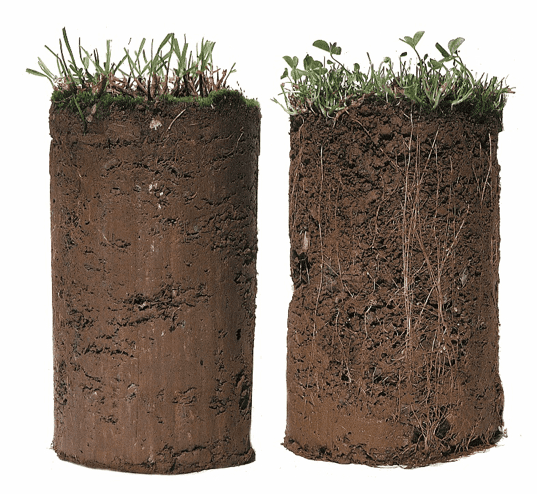
Studies at IBERS have demonstrated improved soil structure resulting from a greater white clover component in the sward:
- White clover has been shown to significantly decrease the density of soils and increase porosity
- Fertiliser recovery from soils with improved structure due to white clover was shown to increase from less than 50% to over 75%
- General movement of nutrients was improved, with the result that more grass was produced
The grass-clover balance
The proportion of white clover in a grass/clover sward is commonly visually over-estimated, typically by twofold. The images below should be used as a guide to achieving the optimum balance as described later.
If clover does become dominant (i.e. when very little grass is visible), then it can out-compete the grass component and unbalance the sward. This may lead to increased weed ingression and greater vulnerability of the clover to winter damage.
This is most common in the second year of a ley, and a more desirable grass/clover balance will be seen in the third year and beyond.
If clover dominance is a problem
- Avoid regular silage cutting sequences, as the regular removal of nitrogen will encourage more clover
- Consider using smaller leaf clover varieties in future
- More intensive grazing, particularly by sheep, will suppress the clover
- Tactical application of nitrogen to enhance grass growth
Sward composition
Maintaining an optimum dry matter balance of 30% white clover to 70% grass as an average across the season is the key to grass/clover sward management, as this is expected to provide the best exploitation of the clover’s nutritional and nitrogen-fixing attributes alongside high yielding grass.
In the past, white clover growth patterns and the nature of the interaction with grass have tended to cause significant seasonal variation of clover content in swards – from as little as 5% in the spring up to 60% in summer.
However, clover breeding work at IBERS is producing varieties that are more compatible with modern ryegrasses and have more even seasonal growth curves.

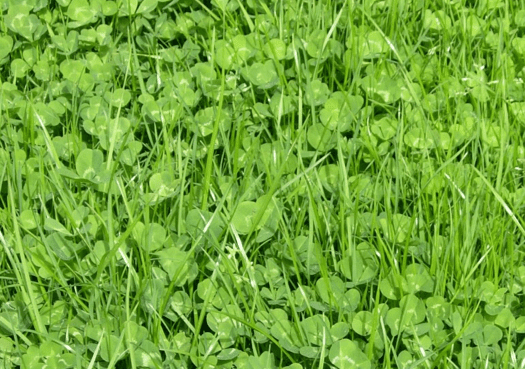
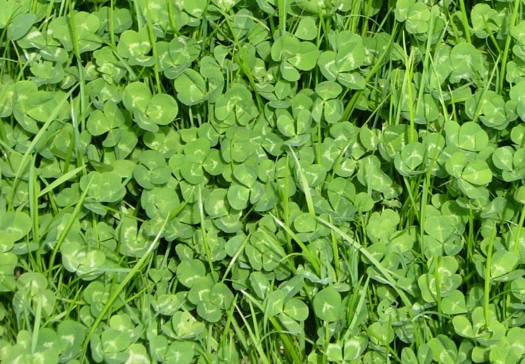
Bloat awareness
Bloat is the excessive build-up of gas (carbon dioxide and methane) in the rumen resulting in distress and possible death due to the exertion of pressure on the animal’s diaphragm, heart and lungs.
Some legumes, including white clover, present an increased risk of bloat (due to the rapid breakdown of protein in the rumen) if the correct management is not applied.
Effective management procedures to minimise or eliminate the risks of bloat in livestock grazing clover-dense swards should include:
- Limiting access to swards when stock is first introduced
- Avoiding turnout of hungry stock
- Feeding high dry matter forage such as hay/straw prior to turnout
- Offering hay/straw at intervals (e.g. to dairy cows at milking times)
- Feeding an anti-bloat feed additive
- Monitoring livestock
Forging an effective combination
The benefits of combining grass and white clover seed in swards for both grazing and conservation are long-established and well-proven. The most important benefits can be summarised as:
- Improved forage quality and feed value due to a boost in digestibility, intake potential, and protein and mineral content of the sward
- Reduced reliance on fertiliser due to nitrogen fixation
- ‘Soil structuring’ by white clover root systems that can help to overcome problems of soil compaction
Accumulated experience and scientific evidence indicate that the optimum balance is achieved with a clover content of 30-35% of the total annual dry matter yield of the sward.
The clover content of a mixed sward will vary from a low level in the spring (as low as 5% of total dry matter) to as high as 60% in July/August.
This level of variability in the clover content is not ideal from the perspective of managing the feeding value for livestock and can also cause deterioration in sward quality over time.
Hence, greater compatibility between grass and white clover varieties is vital for livestock farmers to gain maximum benefit.
Breeding for compatibility
A compatible white clover and grass seed mix is one with a clover content that is sufficiently large to optimise the nutritional and nitrogen-fixing attributes of the clover when growing with a high yielding companion grass.
Grass and clover varieties differ in their aggressiveness towards each other due to their abilities to compete for nutrients, water and light. At IBERS, breeding for general compatibility is high on the agenda and varieties are routinely tested for this attribute.
Evidence of the progress that takes clover into a new era of utilisation is summarised by three key areas:
- Annual clover contributions of 30% or greater from IBERS-bred varieties have been proven experimentally and are now being seen on the farm
- Compatibility with modern Aber High Sugar Grass varieties (perennial and hybrid ryegrasses)
- Evidence from long-term experiments showing effective levels of clover being maintained in swards for many years under high and low N regimes
Targets
The aim of establishment should be to achieve a minimum of 150 clover seedlings per square metre within a mixed clover/grass sward.
Techniques: How to grow white clover
In a rotational situation, preceding crops should ideally be cereals, roots or brassicas, which lead to reduced nitrogen levels in the soil and encourage clover establishment.
Broadcasting is the most reliable method of establishing a clover-based sward and is generally considered more successful than drilling.
Undersowing to a cereal crop is an alternative, particularly if the cereal is to be harvested early (July) for wholecrop. If undersowing grain crops, cereal varieties should be early maturing and lodging resistant, and cereal seed rate should not exceed 140 kg/ha (56 kg/acre). Grass seed with white clover can be introduced into an existing sward.
Timing: When to sow white clover seed in UK?
April to mid-August is the optimum sowing period for white clover seed on most UK farms. Seedlings must have begun producing stolons before the onset of winter.
Seedbed
A clean seedbed is essential, and this should ideally be ring-rolled prior to sowing. The optimum soil pH is 6.0-6.5. Liming to correct pH should be carried out well in advance of sowing.
Fertiliser nitrogen should only be applied in low N status soils, up to 50 kg N/ha. Phosphate (P2O5) and potash (K2O) is required at application rates of 50-120 kg/ha, depending on soil indices.
Seed rate and sowing depth
White clover seed mixtures should contain between 2-4 kg/ha (0.75-1.5 kg/acre) when sowing white clover, depending on environmental conditions to achieve target establishment and an optimum balance in the sward. The optimum white clover seed depth is 5-10 mm.
Combating pests and diseases
The main pests affecting clover during establishment are:
- Slugs: potentially devastating in problem areas particularly in drilled crops
- Stem eelworm: causes distortion of growing buds and young leaves and death of the plant
- Sitona weevil: more common close to arable areas and leads to the removal of small semi-circular sections of leaflets
- Leatherjackets: more common following the ploughing of old pastures
The most common disease affecting white clover is clover rot (Sclerotinia), which causes a generalised rot of the plant.
It is important to be aware of the risks of both pests and diseases and take the appropriate action, including a selection of new stem nematode-resistant Aber varieties (where available)
and use of agrochemicals following advice from a qualified agronomist.
In the case of damage from pests and disease, the mobility of clover resulting from stolon extension allows rapid re-colonisation by surviving (and possibly resistant) plants, thereby reducing the impact of infestation.
Weed control
First and foremost, a clean seedbed is essential in order to avoid competition from weed species during establishment.
Most annual and some perennial weeds can be controlled by regular pasture topping, but it may be necessary to use herbicides in some circumstances, in which case ensure a clover-safe product is used and only spray if clover plants are vigorous and well developed.
Establishment options
Introducing white clover into an existing sward
White clover seed can be introduced to an existing sward through a variety of methods, from slot seeding to broadcasting following scarification. Greatest success will be achieved by observing the following principles:
- Minimise competition from existing plants prior to sowing by heavy grazing and/or harrowing to open up the sward
- Observe normal sowing timings (April to August) and soil nutrient/pH status parameters
- Take advantage of the period when grass is least vigorous (after flowering in July) if there is sufficient soil moisture, particularly after a silage cut
- Ensure soil is sufficiently disturbed to allow seed contact and coverage (5-10 mm seed depth)
- Use a higher seed rate (4 kg/ha or 1.6 kg/acre) than conventional sowing to compensate for greater seedling loss. Lower seed rates (from 2.5 kg/ha or 1 kg/acre) may be used for a periodic top-up in long term swards
- Use slug pellets as an established sward may well harbour this pest
- Graze lightly and in short periods until clover is well established
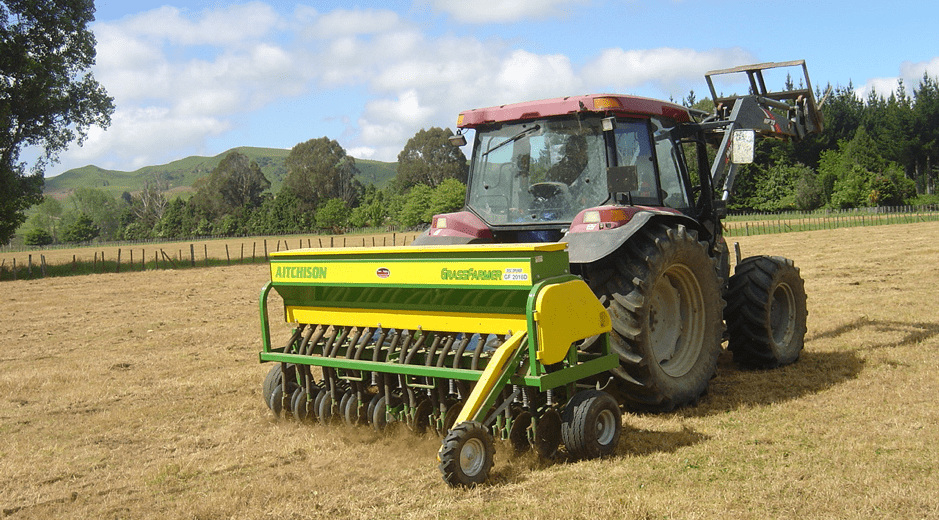
Two-stage establishment
Effective control of annual and perennial weeds in new sown leys has become more difficult due to the withdrawal of some products in recent years.
Specific difficulties occur in relation to clover, so new approaches are required to ensure the establishment of weed-free grass and clover swards.
One such method is to establish a weed-free grass ley in advance of introducing clover, using a two-stage system.
Following an existing ley with perennial weed problems (docks, thistles etc.):
- For autumn reseeds, start the control of perennial weeds in the preceding spring, using a systemic agrochemical that targets the important weeds. For spring reseeds, start weed control in the previous season
- Use glyphosate (3-6 litres/ha) to ‘kill off’ old ley and any surviving weeds
- Sow new ley mix (excluding clover)
- Monitor ley during establishment. Treat weed problems if necessary, from three true leaves of the grass onwards. Non-clover safe options give broader more effective weed control
- Stitch clover into established sward (April to August) at least 6 weeks after weed control (as above)
Following arable crops/maize or weed-free swards:
- Use glyphosate at 1.5-4.0 litres/ha (arable stubbles) or 3-6 litres/ha (grass swards) to ‘kill off’ old ley and any weeds
- Repeat steps 3-5 as above
Check agrochemical application rates with your BASIS qualified supplier.
Grazing systems in practice
Grazing management after planting white clover:
- Observe the size and vigour of stolons in the spring. This will reveal the extent of clover in the sward and allow management to be applied that will increase (e.g. intense grazing) or reduce (e.g. apply nitrogen) the sward clover content
- Ensure the appropriate variety is grown for intensive grazing (AberHerald)
Avoid excessive stolon damage through poaching - Use intensive grazing, particularly by sheep, as a brake on clover content or less frequent cutting to increase clover content
- Keep grass at 4-6 cm over winter to protect stolons from frost damage
- Choose Aber High Sugar Grass varieties as suitable companion grasses and the best clover varieties of appropriate leaf size for the system
Continuous grazing
- Use smaller leaf varieties to withstand hard grazing pressure
- Modern varieties grown with compatible Aber High Sugar Grass varieties in long term leys can sustain high dry matter yields for the duration of the ley, assuming low nitrogen fertiliser inputs
Rotational sheep grazing
- Modern medium leaf varieties are most suitable
- Consider the inclusion of small leaf varieties where grazing pressure is heavy
- Swards with 30% content can be maintained for at least 10 years, with total sward dry matter yields of 10-11 t/ha/annum
- The use of modern nitrogen-tolerant Aber varieties in combination with compatible Aber High Sugar Grass varieties enables high clover content swards to be maintained even with nitrogen fertiliser levels up to 250 kg N/ha/annum
Rotational cattle grazing
- Modern medium-leaf varieties grown with compatible companion grasses can provide a total sward dry matter yield of 11-13 t/ha/annum when following RB209 Fertiliser Manual guidelines
- Longevity of the sward is determined by the companion grasses, with perennial ryegrass offering up to eight years, hybrid ryegrass up to three to four years, and Italian ryegrass two to three years duration
- Modern nitrogen-tolerant varieties (such as AberDai) perform well in swards receiving up to 250 kg N/ha/annum
- Where swards are cut frequently (for silage) it is beneficial to include a proportion of the content as large leaf varieties
Key developments
Plant breeders at IBERS have been focused on a range of resource-efficient criteria in addition to more conventional breeding objectives.
Drought tolerance
New varieties are emerging from the IBERS clover breeding programme that are better able to cope with potential climate change scenarios.
Improved drought tolerance has been introduced into the breeding programme through the development of hybrids between white clover and Caucasian clover (Trifolium ambiguum), a drought-tolerant, rhizomatous species.
These new varieties are white clover-like in appearance and combine the agronomic performance of clover with the drought tolerance of Caucasian clover.
A further potential advantage of these hybrids is the better persistence of large-leaved varieties under different management systems.
In the chart below, three new lines from the hybrid breeding programme with improved drought tolerance are shown in comparison with the established white clover variety AberHerald.

AberLasting is the first white clover variety to be developed at IBERS with rhizomatous root characteristics, transferred from the more drought-tolerant Causasian clover species.
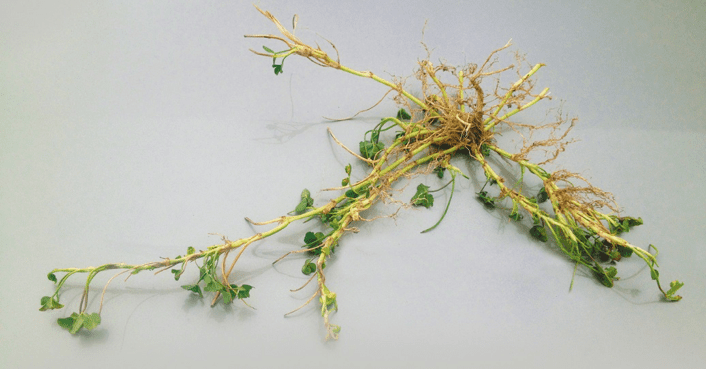
Phosphorous use efficiency
Phosphorous (P) is one of the most important determinants of yield of grasslands.
In response to concerns over the future availability of phosphorous and the environmental impact it has in rivers and watercourses, the IBERS white clover breeding programme is developing varieties that can grow in low-phosphorous soils and make better use of the nutrients available.
New varieties from the programme, now in trial, are offering the possibility of reducing fertilizer P inputs to swards.
Nitrogen use efficiency
One of the main attractions is the high protein content, which can be greater than 25% of dry matter. Where conditions are optimum for overall yield, the protein content can exceed the nutritional requirements of grazing ruminants and are lost through their excreta. This can make a significant contribution to overall agricultural losses.
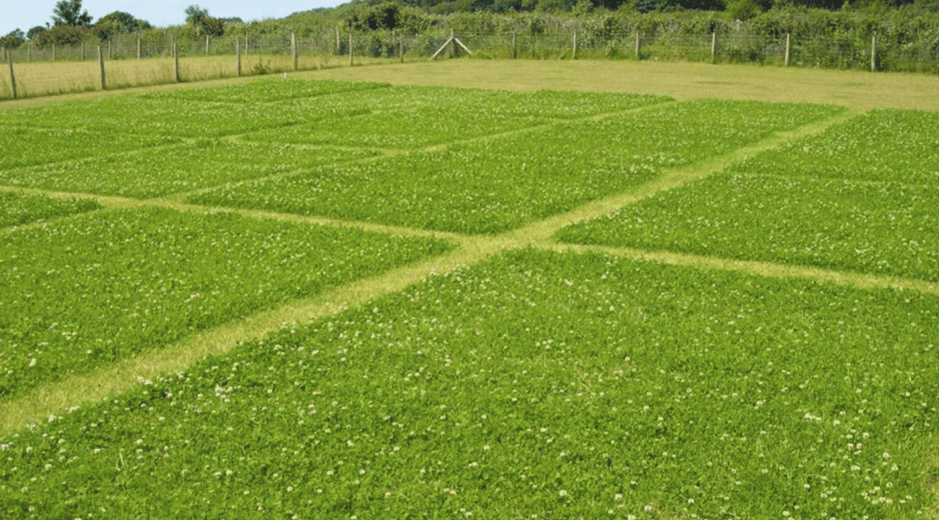
Fertility building
Many successful low-input and organic systems rely on a legume-based fertility building ley phase as an alternative to mineral N applications and there is increasing interest in using these systems more widely. White and red clover seed can both be sown to produce crops that build fertility in these systems to the benefit of the following crops.
Variety choice
Aber white clovers: small leaf varieties
AberAce
The small leaf clover AberAce is particularly useful under continuous sheep grazing. AberAce is used in blends with other varieties of differing leaf sizes to provide a very dense base to any clover blend. Small leaf clovers are mainly used in long term leys for hard grazing.
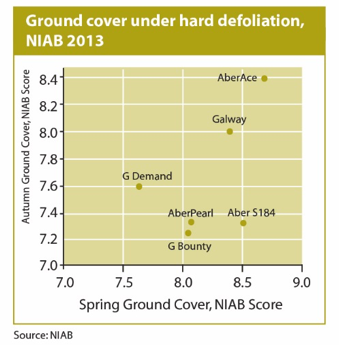
AberPearl
A very flexible variety, AberPearl should be used in all grazing situations, either for sheep or cattle. AberPearl is suitable for inclusion in long term mixtures where persistence is key and can also be combined with other clover varieties of greater leaf size.
AberLasting
The first variety from the IBERS breeding programme to incorporate traits introduced from Caucasian clover, a closely related and highly drought-tolerant species.
AberLasting was developed by conventional crossing techniques and has all the characteristics of a small-leaf clover, but with the drought-tolerance of Caucasian clover. It is suitable mainly for use in long term leys where water limitation may be a concern.
Aber white clovers: medium leaf varieties
AberHerald
AberHerald is designed for use in rotational sheep and cattle grazing systems including cutting for silage. AberHerald is ideal for farms where spring growth is key, as its rapid growth characteristics allow it to perform even when day lengths are shorter.
AberDai
AberDai is very flexible and despite its large leaf size it can be used for hard grazing as well as cutting mixtures. It is very winter hardy and therefore highly appropriate in many parts of the UK. AberDai can be used where the ability to be flexible is key and can be used in either medium or long-term leys.
Aber white clovers: large leaf varieties
Aran
Aran is a high-yielding, large leaf clover. It is highly versatile, being suitable for rotational grazing or cutting.
Blend or single variety?
AberClover blends offer the livestock farmer similar advantages to those that grass mixtures have over a single grass variety monoculture sward.
On most farms, environmental conditions and management systems can vary from year to year. Blends of the latest Aber varieties combine complementary characteristics and offer greater stability of yield than single varieties.
Blends also capitalise upon this clover’s ability to re-colonise areas left vacant by more vulnerable plants, by means of its creeping stems (stolons).
AberClover Blends have been formulated for specific uses, taking into account the individual characteristics of Aber white clover varieties.
AberDairy
Formulated from a combination of the medium and larger leaf size Aber clover varieties, providing a blend suitable for the dairy farm where high production is required under cattle grazing and cutting regimes. Good production from early spring provides a balanced clover coverage sward and good support for high yielding companion grasses.
AberPasture
Selected Aber clover varieties provide a unique blend of small and medium leaf size clovers selected for their suitability for cattle grazing and rotational sheep grazing.
AberSheep
Small leaf size Aber white clover varieties combined with a medium leaf size variety provide a blend suitable for sheep systems ranging from continuous to rotational grazing on either upland or lowland farms.
Talk to us about white clover
Red clover seed guide
